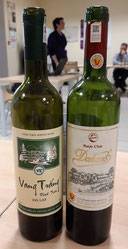wine production in vietnam
I learnt from a couple of Asian tourists who came on a wine tour with me in 2018 that there was a small wine production in Vietnam. They told me that Sauvignon Blanc was grown there – a piece of information that I haven't had the opportunity to check though. It was nevertheless a real discovery, since I thought it was way too hot and humid in this country to grow grapevines.
It is the French who introduced viticulture in Indochina in the 1880s. They quickly realized that heat and humidity were indeed real obstacles to grape-growing, especially in the plains. They then moved to the region of Dalat (Đà Lạt in Vietnamese), a city located in the highlands in the center of the country, at 1,700 meters above sea level, where the climate is consequently more temperate. Today, Dalat is still the capital of Vietnamese wine. It is nevertheless too cool there for the grapes to reach full maturity: 90% of the production comes from about 100 kilometers from there, in the region of Ninh Thuan, located between Dalat and the coast. The grapes are bought from local farmers by the wineries, then transported by truck to Dalat where, thanks to the cool climate, the winemaking and ageing conditions are optimal.
The climate allows the vines to yield up to 3 harvests a year. The absence of dormancy considerably reduces the lifespan of the vines: 8 to 15 years on average.
The production is not very high: about 20 wine estates produce on average 10 million liters a year on 3,000 hectares, which means yields of 33 hectoliters on average. And for some good reasons, the Vietnamese consume more beer than wine. Their personal wine consumption nevertheless increases a little each year, especially thanks to the rise of middle and upper classes. In 2014, wine consumption was of 6.5 liters per inhabitant and per year - against 44.2 liters per person and per year in France, which remains the second country in the world after the USA in terms of consumption per capita and per year.
During a trip to northeast Vietnam in November 2018 - for once, wine tourism was not the main goal of my trip abroad - I had the opportunity to taste two Vietnamese wines. But no Sauvignon Blanc - it is red wine that I tried, made from Cardinal. This grape variety was created in the United States in 1939 and introduced in France in 1946, where it is classified as table grape - in fact, today it is one of the most produced table grapes in the world. In Vietnam, this red grape is vinified both as red and white wines. There are also some Vitis Vinifera plantations - Cabernet Sauvignon, Chardonnay, Syrah - but they are more than rare.
The first wine I tasted was in a restaurant in the town of Lang Son, not far from the border with China. I saw bottles of red wine in a fridge (!) when entering the restaurant, so this was the first opportunity for me to taste local wine. It was made by Dalat Beco, one of Vietnam's most famous and important wineries. Founded in 2000, it produces around 700,000 bottles a year, mainly from Cardinal. Our guide kindly warned us that the wine was probably not going to be very good. But in the end, it was quite correct. Its particularity: it was made from fermented grapes and blackberry juice - the fruit of the mulberry tree, which gives the leaves on which the silkworms feed - to give it a little more color. Same blend in the second wine tasted a few days later, and in the third one, bought at Hanoi airport and tasted with a wine club in France. The addition of blackberry juice was clearly visible in the latter wine, whose color looked like that of grenadine syrup.

I also brought back a bottle of white wine, bought in a wine shop in Hanoi's Old Quarter. Once again, the wine had a very intense colour, almost amber-yellow, reminiscent of an old wine. The nose smelt of herbs... and in the mouth, the wine gave me the impression of eating honey and eucalyptus candies. Not really convincing to me...
By the way, wine is said 'vang' in Vietnamese. This is the phonetic transcription of what is perceived by Vietnamese people when they hear the word 'vin' in French.
To conclude, it is not for wine that people go to Vietnam, but to discover a country with many facets and a chaotic but fascinating history. I only discovered a small part of it, so this twelve-day trip left me unsatisfied. From the mythical Ha Long Bay, to the superb karstic landscapes of the Cao Bang province and the vibrant and dynamic city of Hanoi... without forgetting the welcoming smiles of the Vietnamese and the food that is so varied and delicious... all these discoveries still nourish me on a daily basis and have left me with a strong desire to go back as soon as possible.
So I went back in December 2019!
The tasting of the white wine mentioned above had frankly left me unsatisfied and I wanted to try some more. On three occasions, I was able to taste Dalat white wine during this second trip. One of the wines tasted like the one mentioned above, with aromas however less pronounced and therefore more pleasant to drink. The second wine was perfectly correct, simple, not very aromatic, but fresh and therefore pleasant to drink, especially because it was served with grilled fish. Finally, the last wine was certainly the most interesting with floral and fruity notes reminiscent of Gewurztraminer. Tasted with oysters cooked on a boat in Halong Bay... not bad, isn't it?













Write a comment
Leeson (Wednesday, 10 July 2024 03:49)
Hello, nice to meet you. I'm Leeson, a supllier of glaaa bottles from China.